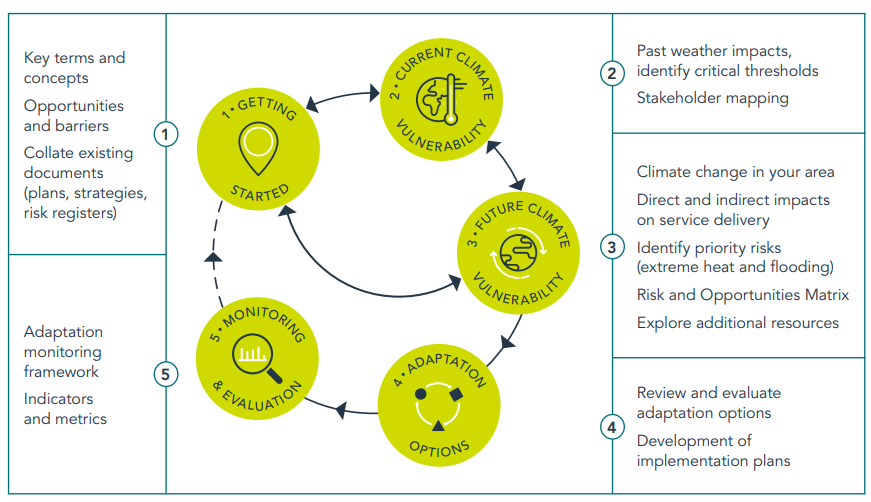How We Did It: Transforming your council to identify climate risk and embed resilience

Many councils have committed to Net Zero, but embedding climate resilience into whole-organisation transformation remains a major challenge. Integrating climate risk into strategic planning is necessary to support future service delivery.
At this ‘How We Did It’ we put Emma Bull, Local Partnerships, and Emily Bolton, Cambridgeshire County Council, in our hot seat to learn about best practices for embedding climate resilience across council operations. They shared insights into their work using the Local Partnerships Climate Adaptation Toolkit and reflected on key learnings from their experience. Using outcomes focused relational working comes with its challenges, but it has the potential to reduce demand on statutory services and help local authorities to effectively deliver preventative interventions.
Interview highlights
On Local Partnerships’ Climate Adaptation Toolkit
The Climate Adaptation Toolkit and risk matrix is a five-step process. It’s designed to help local authorities prepare for the impacts of climate change on their organisation, services, and residents. It’s freely available, and it’s designed to guide you through each stage of developing a strategy and adaptation plan. It seeks to bridge the technical guidance from the Climate Change Risk Assessment (CCRA3) and the practicalities of local government. Having good relationships is really important, it’s not all about short term fixes – quite often we can’t achieve those. We share the problem, not just the solution.

On embedding climate goals into service redesign
We know that climate change will impact every service at every level, and this means there will need to be a change in how councils operate and make decisions. Councils must consider the impacts of these increasing incidents of extreme weather, what they are having on their services, their people, and their communities, and transform their ways of working by embedding climate goals into service redesign and within their governance and strategy.
Considerations must be made early on in projects and integrated into business cases, project briefs, and risk assessments. It’s essential not to view climate considerations as an additional factor, but rather to create a unified approach and ensure they are integrated into an existing transformation project or service redesign.
On collaboration across councils
For a council to adapt its core services to mitigate climate impact, collaboration is key. All services will be affected in some way at some point, not necessarily simultaneously, but often there are indirect impacts. It is therefore essential to raise awareness and gain buy-in internally across your entire organisation.
Ideally, you need that endorsement from the senior levels to undertake this work. Both a top-down and a bottom-up approach are required to ensure that engagement and collaboration with as many people as possible are achieved internally.
On collaboration across systems
Those extreme weather events aren’t isolated, and they don’t respect boundaries. So, it’s important to work and collaborate with stakeholders across places to identify risks and determine who the risk owners are.
Having oversight of where accountability sits across the sector is crucial when defining roles and responsibilities for action.
On communicating with communities
The more you can work with your residents and communities, and raise their awareness of how the climate is impacting your services, the better things will be when these events occur.
It is helpful to establish relationships that can be used to help manage expectations and ensure people are aware of when and where services are affected or unavailable in the event of climate-related issues.
On Cambridgeshire County Council’s work on this
We’ve been looking more broadly at climate change mitigation, as well as climate adaptation, and working with partners on the external focus. We’ve used the Local Partnerships toolkit as a framework to help us delve deeper into how climate change will manifest across our various services. We’ve taken great value from having an external third party come in and convene workshops for staff across services and levels.
So it becomes something that feels a little more corporate and less like a climate team doing climate-related work, which can be really helpful for conveying that it affects everyone in slightly different ways.
It helps to make it a real issue for staff in the present, not just something that future officers will have to deal with. However, it also helps to highlight that some services will need to adapt more swiftly than others.
On moving from reactive to proactive
In the short term, a shift is needed away from being overly reactive to climate events, such as floods, where we trigger the emergency plan. For climate adaptation, we need to be more proactive, focusing on service transformation and designing services to prevent issues from escalating into emergencies in the first place.
On collaboration within Cambridgeshire
There’s no avoiding speaking to people across services about climate; there has to be a coming together of the different professional areas to understand and really delve into what impacts and solutions might be for different areas.
We started off with a webinar for our councillors, which was extremely well attended, to secure that political buy-in. We then spoke to all of our senior management teams to raise awareness that climate risk is something we need to address. This then helps legitimise officers from their departments coming and participating in these workshops and this type of work.
Photo by Chris Gallagher on Unsplash.
 Join our mailing list
Join our mailing list

